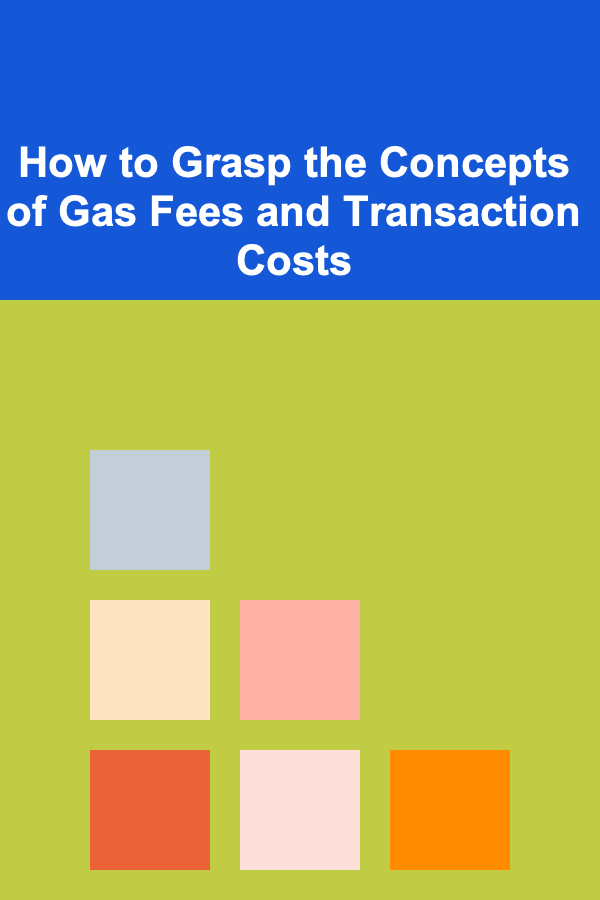
How to Grasp the Concepts of Gas Fees and Transaction Costs
ebook include PDF & Audio bundle (Micro Guide)
$12.99$10.99
Limited Time Offer! Order within the next:

In the world of cryptocurrency, blockchain technology, and decentralized finance (DeFi), understanding gas fees and transaction costs is essential. As a growing number of users engage with blockchain networks, the concepts of gas fees and transaction costs can seem complex, especially for newcomers. However, by breaking down these ideas into their core components, it's possible to gain a clear understanding of how they function, why they exist, and how they impact users on a day-to-day basis.
This article will explore the essential aspects of gas fees and transaction costs, with a focus on how they work within blockchain networks like Ethereum and Bitcoin. Additionally, we will discuss the role of these fees in ensuring network security, facilitating decentralized operations, and the ways in which they impact the broader crypto ecosystem.
What are Gas Fees?
In blockchain networks, the term "gas" refers to the computational effort required to perform operations, particularly on platforms like Ethereum. Gas is used to measure how much computational work is involved in executing transactions or smart contract operations. Gas fees, on the other hand, are the payments made by users to compensate for this computational work.
Gas fees are necessary because every transaction or operation executed on the blockchain requires computational resources. This can include simple operations, such as transferring tokens from one wallet to another, or more complex tasks, such as executing smart contracts, minting new tokens, or interacting with decentralized applications (dApps). Since these operations take up valuable computational power, gas fees are used as an incentive for miners or validators to process and confirm the transactions.
Why Are Gas Fees Important?
Gas fees serve multiple purposes within a blockchain network. Primarily, they act as:
- Incentives for Miners and Validators: Gas fees compensate miners (in Proof of Work systems like Ethereum) and validators (in Proof of Stake systems) for their efforts in processing and validating transactions. This incentivizes them to maintain the network and secure it against fraud.
- Resource Allocation: Gas fees help allocate computational resources efficiently. Transactions with higher gas fees are prioritized over those with lower fees. This ensures that the blockchain remains fast and efficient, even when the network is under heavy usage.
- Preventing Spam and Network Abuse: By requiring users to pay for transaction processing, gas fees discourage spamming the network with unnecessary or malicious transactions. It helps to ensure that only legitimate and valuable operations are performed.
- Network Security: Gas fees contribute to the overall security of a blockchain network by making it costly for bad actors to launch attack vectors like Sybil attacks or DoS (Denial of Service) attacks, which could otherwise overload the system.
How Gas Fees Work in Ethereum
In the Ethereum blockchain, gas fees are calculated based on the gas limit and gas price:
- Gas Limit: The maximum amount of computational work a transaction is allowed to consume.
- Gas Price: The amount the user is willing to pay per unit of gas. It's often measured in Gwei, which is a small denomination of Ethereum (ETH).
The total transaction fee in Ethereum is calculated as:
Total Fee=Gas Limit×Gas PriceIf a user wants to execute a transaction with a higher priority, they can increase the gas price to incentivize miners to prioritize their transaction. Conversely, if the network is not busy, a user can lower the gas price to save costs.
Gas Fees in Other Blockchains
While Ethereum is the most popular platform that uses gas fees, other blockchains also use similar mechanisms for compensating network validators. For instance:
- Bitcoin: Transaction costs in Bitcoin are determined by the size of the transaction in bytes and the overall congestion of the Bitcoin network. While Bitcoin doesn't use a "gas" model in the same way as Ethereum, transaction fees still exist to encourage miners to include a transaction in the block they are mining.
- Binance Smart Chain (BSC): Similar to Ethereum, BSC also uses gas fees to incentivize validators to process transactions. BSC uses a simpler fee structure that tends to be lower than Ethereum's, making it a popular choice for users looking for cheaper alternatives.
- Polkadot: Polkadot has a unique fee model where gas is used for both transaction processing and the execution of smart contracts. Polkadot's design is meant to scale and provide lower transaction costs.
Transaction Costs and Their Significance
Transaction costs, sometimes referred to as network fees, are the broader category of fees that users pay to facilitate the transfer of value across blockchain networks. While gas fees specifically refer to the computational costs involved in executing operations, transaction costs encompass all the associated costs, including network congestion, block space, and any intermediary services.
Factors Affecting Transaction Costs
Transaction costs can vary significantly depending on the blockchain, the complexity of the transaction, and the current state of the network. Some factors that affect transaction costs include:
- Network Congestion: During times of high demand, gas fees tend to rise, as users compete to have their transactions included in the next block. This phenomenon is common in blockchains with high transaction throughput, such as Ethereum during periods of decentralized finance (DeFi) booms.
- Transaction Complexity: Simple transactions, like transferring tokens from one wallet to another, generally incur lower fees than more complex operations, like interacting with smart contracts or executing dApp functionalities.
- Block Size and Transaction Capacity: Each blockchain network has limitations on the number of transactions that can be processed in a single block. Networks with smaller blocks often experience higher transaction costs due to limited space.
- Consensus Mechanism: The method used to validate transactions and maintain the blockchain can affect transaction costs. Proof of Work networks, like Bitcoin and Ethereum (pre-ETH2.0), require more energy and computational power, which can result in higher fees. Proof of Stake and other alternative consensus mechanisms generally lead to lower fees due to their less resource-intensive nature.
Examples of Transaction Costs in Popular Networks
Ethereum
Ethereum, due to its widespread usage and the complexity of its transactions, has some of the highest transaction fees. During periods of high network activity, gas fees can reach astronomical levels, causing users to either delay transactions or search for alternative networks. However, the Ethereum community is actively working on scalability solutions, such as Ethereum 2.0, which aims to reduce transaction costs by transitioning to Proof of Stake.
Bitcoin
Bitcoin's transaction fees are primarily determined by the size of the transaction (measured in bytes). Since Bitcoin's block size is limited, the more complex the transaction (such as a multi-signature or multi-input transaction), the higher the transaction cost. Bitcoin's fees tend to be lower than Ethereum's, but they can still rise during periods of network congestion, such as during bull runs or when the network experiences a backlog.
Binance Smart Chain (BSC)
BSC, in contrast to Ethereum, has become popular due to its lower transaction costs. Its fee structure is relatively straightforward, with smaller transaction fees due to its more efficient consensus mechanism (Delegated Proof of Stake) and faster block times. BSC has positioned itself as a more affordable alternative for DeFi users looking to avoid Ethereum's high gas fees.
Solana
Solana is another blockchain that prides itself on low transaction fees. By using a highly optimized Proof of History consensus mechanism and cutting down on the complexity of transactions, Solana is able to offer near-zero transaction fees, even during periods of high traffic.
Impact of Gas Fees and Transaction Costs on Users
Gas fees and transaction costs play a significant role in the overall user experience on blockchain networks. They influence everything from how people interact with decentralized applications to the viability of new projects and products within the ecosystem. Here are some of the key impacts:
- Usability and Accessibility: High transaction costs can hinder the widespread adoption of blockchain technology, especially for small-value transactions. For example, paying high gas fees for a small token transfer could make Ethereum impractical for everyday use. Lower transaction costs, as seen in BSC or Solana, offer users more affordable options for engaging with blockchain-based applications.
- Profitability of Projects: For developers building decentralized applications, the cost of gas fees can impact the financial viability of their projects. If transaction costs are too high, users might be discouraged from interacting with the dApp, reducing its user base and limiting its potential for success.
- Scalability and Network Growth: High transaction fees can stifle the growth of blockchain networks by making them inaccessible to new users. Scalability solutions, such as sharding or Layer 2 protocols, aim to address this issue by increasing transaction throughput without raising costs.
Managing Gas Fees and Transaction Costs
While users cannot avoid transaction fees altogether, there are strategies they can use to minimize the impact of gas costs. Some tips include:
- Optimizing Transaction Timing: Gas fees fluctuate based on network activity. By monitoring gas prices and conducting transactions during off-peak hours, users can reduce costs.
- Using Layer 2 Solutions: Layer 2 protocols, such as Optimism and Arbitrum on Ethereum, offer a way to perform transactions off-chain, reducing the load on the main Ethereum network and lowering gas fees.
- Choosing the Right Blockchain: If transaction costs are a concern, users can consider using alternative blockchains like Binance Smart Chain or Solana, which have lower fees.
- Batching Transactions: When interacting with multiple addresses or performing repetitive tasks, batching transactions into a single operation can reduce the overall cost of gas.
- Setting Custom Gas Limits: By customizing the gas limit and price, users can control how much they are willing to spend on a transaction, helping them avoid unnecessary overpayment during periods of low network congestion.
Conclusion
Gas fees and transaction costs are integral to the functioning of blockchain networks. They serve as mechanisms for incentivizing network validators, preventing spam, and ensuring that blockchain transactions are secure and efficient. While gas fees can sometimes be high and seem prohibitive, there are various ways to mitigate costs and optimize blockchain use. As blockchain technology continues to evolve, we can expect the development of more efficient solutions, such as Ethereum 2.0, Layer 2 scaling, and low-fee alternatives like Solana, to make decentralized networks more accessible and affordable for users around the world.
Reading More From Our Other Websites
- [Home Security 101] How to Prevent Garage Door Theft and Break-ins
- [Home Pet Care 101] How to Choose the Right Dog Boarding at The Ranch
- [Personal Care Tips 101] How to Choose Hand Cream for Post-Manicure Care
- [Mindful Eating Tip 101] The Science Behind Mindful Eating: Why It's a Game‑Changer for Diabetic Health
- [Organization Tip 101] How to Create a Sustainable Seasonal Wardrobe
- [Home Rental Property 101] How to Keep Your Rental Property Safe and Secure for Tenants
- [Sewing Tip 101] Sewing Adventures: 10 Easy Projects Every Kid Can Master
- [Stamp Making Tip 101] Top Must-Have Tools for Beginner Stamp Makers
- [Home Rental Property 101] How to Keep Up with Market Trends in Rental Properties
- [Personal Care Tips 101] How to Refresh Your Skin with Body Spray During the Summer Heat

How to Keep Your Office Clean and Clutter-Free
Read MoreHow to Use Tracking Numbers for International Dropshipping Orders Effectively
Read More
How To Create Shareable Infographics
Read More
How to Save Money on Travel Insurance: A Comprehensive Guide
Read More
How to Design a Morning Routine Checklist for Creative Professionals
Read More
10 Tips for Building a Realistic New Year's Resolution Checklist
Read MoreOther Products

How to Keep Your Office Clean and Clutter-Free
Read MoreHow to Use Tracking Numbers for International Dropshipping Orders Effectively
Read More
How To Create Shareable Infographics
Read More
How to Save Money on Travel Insurance: A Comprehensive Guide
Read More
How to Design a Morning Routine Checklist for Creative Professionals
Read More